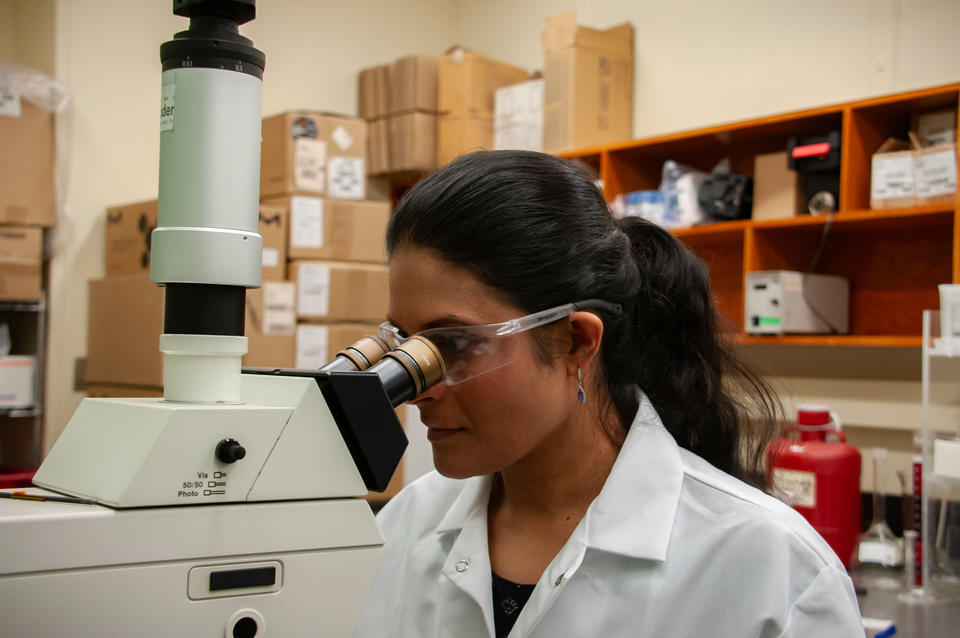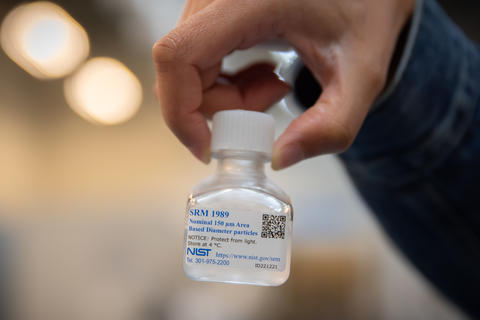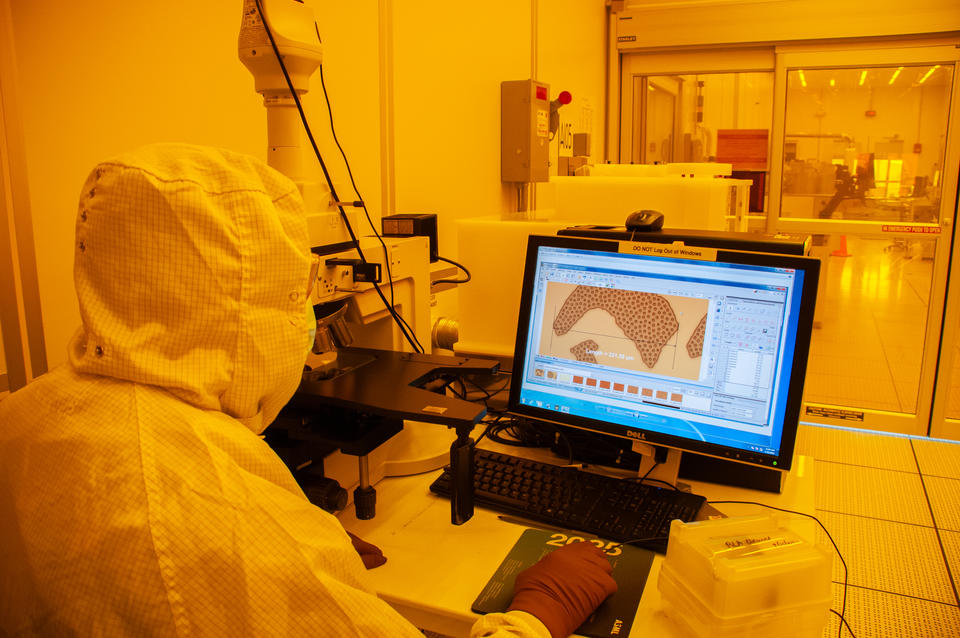- Drugs made with genetically engineered proteins, called protein-based biotherapeutics, are used to treat cancers, autoimmune disorders and other diseases.
- Impurities in these drugs can cause undesirable immune responses in patients and can significantly drive up costs for drug manufacturers.
- NIST has developed a standard reference material to help biopharmaceutical manufacturers better detect particulate impurities so they can maintain drug product quality while reducing costs.

Protein-based biotherapeutics are drugs made with genetically engineered proteins. These large protein molecules can stick together during the drug manufacturing process to form particles. A team of NIST researchers, including Srivalli Telikepalli (shown here), developed a standard reference material that will help biopharmaceutical companies better detect these particles in their drug products.
A rapidly growing category of drugs called protein-based biotherapeutics can be used to treat cancers and genetic and autoimmune disorders. These drugs, which usually take the form of large protein molecules, are manufactured by growing living cells that are genetically engineered to produce the proteins. These large protein molecules, however, can stick together during the manufacturing process to form particles that can cause an unwanted immune response in patients.
To manage these particles, biopharmaceutical companies need to be able to measure and monitor them. A new standard reference material (SRM) from the National Institute of Standards and Technology (NIST) will help them do that. The new material, SRM 1989: Monodisperse Irregularly Shaped Epoxy-Based Particles, consists of three vials containing particles of different sizes: 220 micrometers, 150 micrometers and 100 micrometers. (For comparison, a sheet of regular printer paper is roughly 100 micrometers thick.)
“This material will be the first publicly available visible particle standard for protein-based particles in biotherapeutic drugs,” said NIST research chemist Srivalli Telikepalli. “This will help drug manufacturers monitor particles in their products so that they can ensure that those products are safe and effective.”

Protein-based particles, which are small but sometimes visible to the naked eye, form because proteins can be unstable. Any stress, like a temperature change or sudden shaking of a drug vial, can cause proteins to clump together into particles. This can happen when the drug products are being purified, packaged, shipped or stored for long periods of time.
At biopharmaceutical manufacturing plants, trained analysts visually inspect each vial of drug product. If the vial contains visible particles, it is removed from the batch. If a certain number of vials fail, the entire batch will be discarded. Each failed batch can cost the manufacturer millions of dollars.
“Without a particle size standard for reference, errors can occur, as different analysts may perceive particles differently. Because of this, the inspection process can be subjective,” said Telikepalli. “Our new reference material will help make the particulate inspection process more uniform.” The SRM can be included in training kits to mimic protein particles and help train analysts to accurately identify these particles in each drug product.
Inspections can also be automated using laboratory instruments. Instrument manufacturers can use the NIST SRM to ensure that their instruments are working properly and to improve their accuracy over time. Analysts can also use the SRM to validate their automated inspection process that uses these laboratory instruments to make sure the process is accurate.
For both manual and automated inspections, a more accurate and uniform inspection process can help ensure that drug batches are not discarded unnecessarily.
To make the particles, NIST researchers shined ultraviolet (UV) light onto a silicon wafer coated with an epoxy-like substance that hardens when exposed to UV light. This created a pattern of particles on the wafer. The same technique, called photolithography, is used when creating microscopic electronic circuits on computer chips. The particles were then removed from the wafer and put into a liquid mixture, or solution. This was done at NIST’s Center for Nanoscale Science and Technology, an important center for semiconductor manufacturing research.

The particles resemble protein particles — irregular in shape and transparent. And crucially, they are all essentially the same size. “Because of our measurement capabilities, we are able to reliably verify the size of these particles with very high precision,” said NIST electrical engineer Michael Carrier.
Using a semiconductor manufacturing technique to simulate protein-based particles is an innovation that might only have happened at a place like NIST.
“NIST has experts in both biopharmaceutical and semiconductor manufacturing,” said Mike Tarlov, chief of NIST’s Biomolecular Measurements Division. “This allows us to bring together measurement expertise from across very different domains to solve real-world problems.”
NIST has produced over a thousand SRMs that support public health and safety and promote U.S. industry. These SRMs help ensure accurate measurements in industries ranging from health and medicine (human urine) to building construction (Charpy Impact Test materials) to semiconductor manufacturing (semiconductor thin film) and many more.
NIST also produces several other SRMs for the biopharmaceutical industry, including a monoclonal antibody protein called the NISTmAb and the NISTCHO — a living cell that expresses a version of the NISTmAb protein. All these SRMs support an industry that’s projected to grow from an estimated $666 billion in 2025 to $1,184 billion by 2032.
SRM 1989: Monodisperse Irregularly Shaped Epoxy-Based Particles is now available for purchase from the NIST Store.

